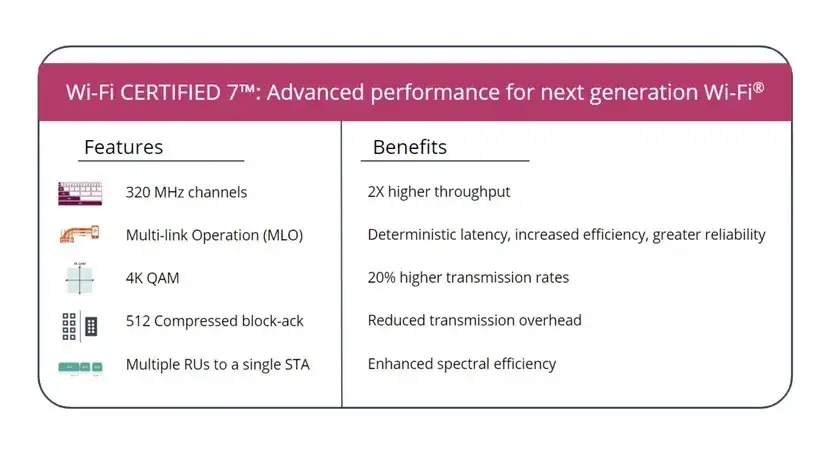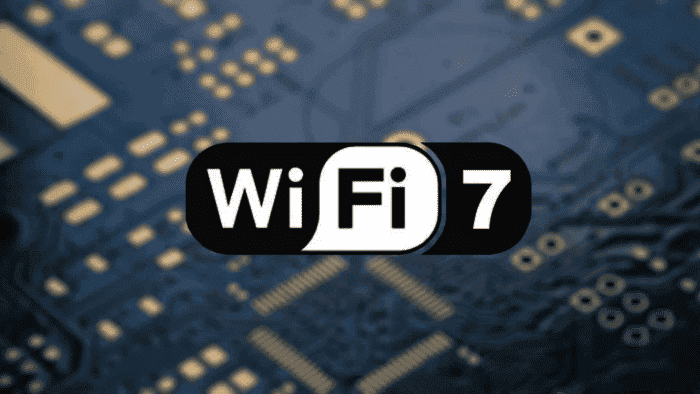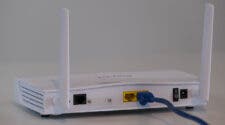A new era of wireless networks is here! The Wi-Fi Alliance has begun certifying Wi-Fi 7 devices to ensure they meet requirements and work well together. The Wi-Fi Alliance stated that Wi-Fi 7 will surpass existing standards in terms of high-bandwidth streaming and low-latency wireless gaming. These are crucial for the popularity of VR games and remote working. Wi-Fi Alliance CEO Kevin Robinson said that Wi-Fi 7 is “the first standard built from scratch specifically for the 6GHz band,” which has a wider and faster wireless spectrum. Although Wi-Fi 6 supports the 6GHz band, it was not built specifically for this frequency band.
Wi-Fi Alliance has also introduced Wi-Fi CERTIFIED 7. It is based on IEEE 802.11be technology and enhances Wi-Fi performance in the 2.4 GHz, 5 GHz, and 6 GHz bands. Wi-Fi 7 brings cutting-edge capabilities to enable innovations that require high throughput, lower latency, and greater reliability across home, enterprise, and industrial environments. These include key applications like augmented, virtual, and extended reality (AR/VR/XR), immersive 3D training, and ultra-high definition video streaming. Wi-Fi 7 networks support advanced Wi-Fi performance for high bandwidth applications. This is to ensure that even in congested environments like stadiums and large campuses, the network remains strong.

Key Features of Wi-Fi 7
- 320 MHz superwide channels that are only available in 6 GHz provide twice the throughput of Wi-Fi enabling multigigabit Wi-Fi device speeds
- Multi-link operation (MLO) supports more efficient load balancing of traffic
- 4K QAM modulation delivers higher throughput and spectral efficiency
- Target Wake Time (TWT) improves battery life in Wi-Fi devices
- Spatial Reuse (SR) enables more efficient use of available spectrum
Benefits of Wi-Fi CERTIFIED 7
- Higher throughput
- Improved support for deterministic latency
- Enhanced efficiency, even in dense networks
- Increased robustness and reliability
- Reduced power consumption
Wi-Fi 7 devices are entering the market today, and Wi-Fi CERTIFIED 7 will facilitate worldwide interoperability. They will also bring advanced Wi-Fi capabilities to homes, enterprises, and industrial environments. Wi-Fi 7 will help with congestion problems, increase densification of the network, and allow for more connected devices. They will also enable new use cases. The certified Wi-Fi 7 are expected to officially hit the shelves before the end of Q1 2024.
The Wi-Fi industry expects to have commercial availability of equipment supporting the next-generation Wi-Fi 7 standard in 2024. The WBA is championing a global Wi-Fi 6E and Wi-Fi 7 program to ensure that industry needs are addressed as Wi-Fi and 5G standards are ratified. The WBA is actively collaborating with its members to conduct field trials of these technologies in key deployment scenarios.

Wi-Fi 7 devices
At the moment, there are already a few Wi-Fi 7 routers in the market. Some of these products hit the market months ago. However, it is still unknown whether these products will obtain Wi-Fi Alliance certification. The certification will make buyers purchase with more confidence and ensure compatibility between devices.
Certifications aside, the standard itself hasn’t changed much since the Wi-Fi 7 guidelines were released last October. Compared with Wi-Fi 5, 6 and 6E standards, Wi-Fi 7’s channel bandwidth has doubled from 160MHz to 320MHz, with a theoretical transfer rate of approximately 46 GBit/s.
Wi-Fi 7 features
One important new feature of Wi-Fi 7 is multi-link operation (MLO). This is a new feature introduced in Wi-Fi 7. In previous Wi-Fi standards, data transmission between two devices took place only through one connection (link), a specific radio channel on a specific frequency. Using MLO, two devices can establish multiple links simultaneously. For example, two tri-band devices communicate in parallel on the 2.4 GHz, 5 GHz, and 6 GHz frequencies. Even if you go out of range of one band, there is no need to reconnect to another band, the network always remains open.

MLO can also reduce latency because the device can flexibly switch to the link with the least interference. If the sender sends the same data over every link, the data will reach the receiver with higher reliability and without interference. If the router and client have multiple radio units, they can also send and receive data simultaneously via MLO. For example, the router sends data to the laptop via 5 GHz, but the laptop sends the data to the router via the 6 GHz link.
However, Robinson also said that not all routers support simultaneous connection to three frequency bands. For example, a more affordable router may only be able to connect to two bands at a time. Nonetheless, this is still a big improvement. After all, the best routers currently only support one frequency band per device, but if you want to experience the full power of Wi-Fi 7, you may still have to spend more money.
Final Words
Wi-Fi 7 is a significant upgrade to the current Wi-Fi technology, bringing advanced capabilities to enable innovations that require high throughput, lower latency, and greater reliability across home, enterprise, and industrial environments. Wi-Fi CERTIFIED 7 will facilitate worldwide interoperability and bring advanced Wi-Fi capabilities to homes, enterprises, and industrial environments. It also has some other technical highlights, such as higher efficiency, throughput and stability. Also worth noting is the fact that devices with this connection are backwards compatible with previous Wi-Fi versions.
Author Bio
Efe Udin is a seasoned tech writer with over seven years of experience. He covers a wide range of topics in the tech industry from industry politics to mobile phone performance. From mobile phones to tablets, Efe has also kept a keen eye on the latest advancements and trends. He provides insightful analysis and reviews to inform and educate readers. Efe is very passionate about tech and covers interesting stories as well as offers solutions where possible.


